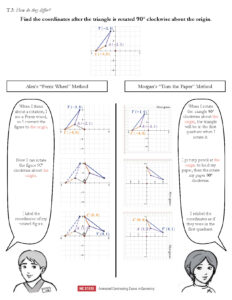Home

What is a geometric dilation? Why does the Pythagorean theorem work? What’s the difference in corresponding and supplementary angles? How do I find the volume of a composite figure?
These are all questions that middle school students are expected to be able to answer. Through our research and the consequent development of these materials, we hope to make the answers to these questions a little easier to understand.
In this collection of materials, we cover four geometric topics: Angles, Transformations, Pythagorean Theorem, and Volume. These topics are discussed in scenarios of contrasting cases, where two fictional students each present a unique method or solution strategy to the same problem. The goal is then to analyze both methods and discuss similarities and differences, strengths and weaknesses of each. Visit the Curricular Materials page to explore each unit.
View the animated materials here!
What makes these materials unique?
Continuing the work done on contrasting cases in algebra by a research team at Harvard, this project:
- aims to digitize and animate the contrasting cases for even greater visual effect, which may lead to more in-depth understanding of the material.
- explores the realm of geometry, a subject often associated with visual learners.
- affords students the opportunity to critique the reasoning of others (in this case, two fictitious students), a skill that is an often-overlooked component of many states’ mathematical standards.